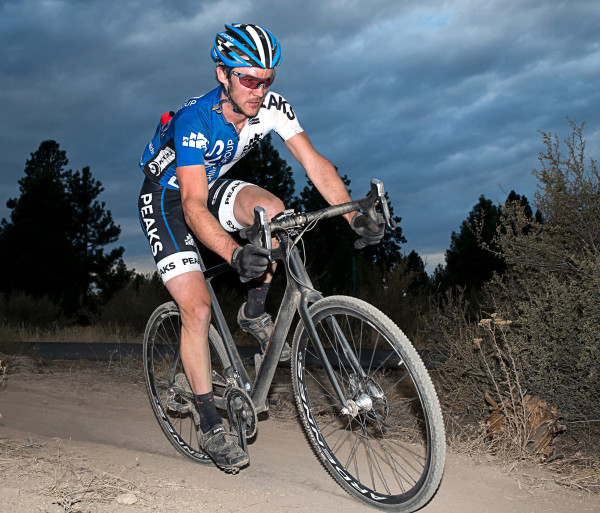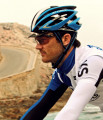by Brig Brandt, Peaks Coaching Group Elite/Master Coach

1. Invest in good tires.
I highly recommend a good, fresh pair of tires to mount up on race day. Just like road tires, MTB tires come in a variety of durometers and thread counts. Use harder tires with a lower tpi for training and softer, suppler tires for racing. Using new or lightly worn tires in races will increase traction and drastically decrease your odds of flatting. Bonus tip: keep a set of mud tires around. When you need them every shop in town will be sold out.
2. Skip the tubes.
Nearly all mountain bike pros are running standard tires (tires meant to be used with a tube) on a tubeless rim, sealed with a tire sealant. This makes for a much lighter wheel set-up and allows lower tire pressure (read: better traction) with virtually no risk of pinch flatting. The downside? The sealant is messy, and it can be difficult to mount tires (a nifty trick is to remove the valve core for increased airflow, seat the tire, and then thread the core back in). I train on my MTB with a tube in my tires but go tubeless on race day.
3. Keep your bars wide.
Know why downhill racers don’t use skinny bars? Because those guys go downhill fast, and you can’t do that with skinny bars. Yes, I know you probably have a trail in your area where you have to squeeze between two trees, but wide bars ride better. They make the bike handle like a dream on descents. Try running the bars at their stock width for a week. If you don’t like it, cut a little off (a little!) and try that for a week. Remember, the general (road) rule of thumb that bars should be shoulder width is not true on MTBs.
4. Use correct tire pressure.
More is not better. More might actually be terrible. I own a digital tire gauge, so I always get the pressure I want: 25 psi in front and 27 in the back, for most courses. When tire pressure is spot on, the awesomeness is exceptional, but only a few psi separate awesome from pinch flats and sliced sidewalls. Play with tire pressure when pre-riding a course, then make sure you have the same pressure on race day.
5. Play with your cockpit.
Cockpit set-up, especially on mountain bikes, is highly personal. Generally speaking, a more upright position will improve descending, and a lower, more aggressive position helps keep the front wheel down for climbs. Brake levers should be somewhat in line with the forearms and easily reached with the preferred braking fingers (nearly all brake levers have adjustable reach). Most mechanics when assembling bikes put the shifters inboard of the brake levers; try it the other way for a ride or two. You might like it.
6. Keep your brakes dialed.
Hydraulic brakes are pretty low maintenance, but when there’s air in the line they are no fun. Keep an eye out for decreased performance and explore different pad options. Metallic pads are powerful, wear slowly, and generally make more noise. Resin pads are softer, wear quicker, and are quiet. I prefer resin pads on my front brake and metallic in the back.
7. Tune your suspension.
As a starting point, set your sag correctly. Remember, if you normally ride with a hydration pack, make sure to have it on when setting sag. More aggressive riders (or those with less travel) might prefer less sag. When riding use a zip tie or rubber gasket to make sure you’re getting correct suspension travel. Unless the terrain is very tame, you should use all (or almost all) of your travel on most rides. Play with rebound and compression damping. Try full compression damping, and then try none. Do the same with rebound. Then start to mix and match. There are no hard and fast rules for suspension, but the manufacturer’s website often has some good guidelines.
8. Ride your mountain bike. Fast.
Okay, so this isn’t a set-up tip, but it shouldn’t be overlooked. When riding a mountain bike at high speeds, the suspension and tire pressure — even pedaling — change. But so many mountain bike racers rarely train hard on their mountain bike; they either ride along with their buddies or race. Doing some intense efforts on the mountain bike will help you get an idea of how differently the bike handles at speed and improve your technical skills.
Good luck out there!
 Brig Brandt is a USA Cycling Level 2 and power certified coach who earned the USA Cycling “with distinction” award for his ongoing commitment to continuing education. He has had the pleasure of coaching masters and professional athletes to multiple national championship podiums and believes that any athlete, even one with limited time, can see significant improvement with focused training. He and our other coaches create custom training plans for all levels of athletes. Brig can be contacted directly through peakscoachinggroup.com or via email at info@peakscoachinggroup.com.
Brig Brandt is a USA Cycling Level 2 and power certified coach who earned the USA Cycling “with distinction” award for his ongoing commitment to continuing education. He has had the pleasure of coaching masters and professional athletes to multiple national championship podiums and believes that any athlete, even one with limited time, can see significant improvement with focused training. He and our other coaches create custom training plans for all levels of athletes. Brig can be contacted directly through peakscoachinggroup.com or via email at info@peakscoachinggroup.com.